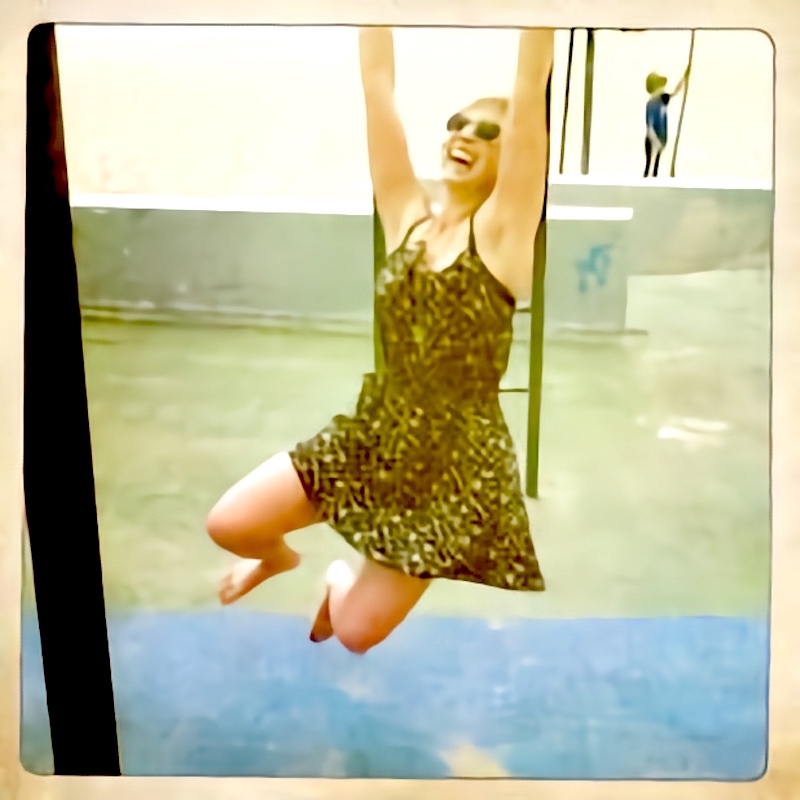Student Blog
What are OS/OT?

Beyond Ergonomics ⟩
January 16, 2013, by Kendra
Classes What are OS/OT?
And let the semester begin!!!
So far this week I have attended Motor Control, Ergonomics, and Lifestyle Redesign and they are all fascinating courses. I am especially excited about Ergonomics, aka ‘the science of work.’
When we think about Ergonomics, we typically think of having a computer workstation designed to best fit your body so as to limit repetitive stress fractures, carpal tunnel syndrome and many other work related chronic injuries.
And while this is a perfect example of Ergonomics, its application is in everything we do, every move we make.
What especially surprised me was our professor telling us how the disks between our vertebrae begin to deteriorate by our 30s. People this is crazy! I’m nearly 30 and determined to have a life filled with adventure and the freedom to move and explore the world as I see fit. As you can see below, sometimes I just have to play on the monkey bars, and it is MUCH harder when you’re adult sized, so I want to minimize my risks as much as possible.

Another thing that blew me away was how typical movement can negatively impact our body. Let me explain. We all know to ‘lift with your knees but not with your back’ but what we don’t consider is how simple movements like bending over to plug in your phone or twisting to reach a paper or high five a friend can damage your vertebral disks. The professor explained it further, that while these movements may be harmful we do them because it’s the most efficient form of movement. So how does one find a happy medium? The best answer is always, always exercise, diet, and be kind to your body.
I’ll keep you posted as I learn more!
⋯

Health and Wellness ⟩
January 16, 2013, by Alisa
Classes What are OS/OT?
I just came out of the Lifestyle Redesign class, and I enjoyed it! During my time as an undergraduate, I had my first exposure to Lifestyle Redesign, working as a student worker at the USC Occupational Therapy Faculty Practice, but I never truly understood what it was all about — or what happens behind closed doors. With the class that I’m taking, I’ll get a rich experience of what Lifestyle Redesign is all about. It is based on practicum, lecture, guest speakers, and observation hours. By the end of class, our instructor, Dr. Dieterle said that we’ll be able to implement similar programs such as weight management, pain management, diabetes management, et cetera. I have always been drawn to health and wellness at a young age. When I was 13, I created an incentive workout program for my family: every 30 minutes on the treadmill equals to 1 raffle ticket, and by the end of each month, we would raffle off prizes! I remember how much fun it was and how my family would line up to use the treadmill. I even committed to using it every day for a month, and I was able to improve my mile time by a minute. Those were the glory days. Now, I enjoy hikes, yoga, and Zumba. As a resident advisor I try to plan programs that involve health and wellness as well from hikes to time and stress management workshops. It is my passion to work in this field, and I hope to own my own health and wellness center some day. 😊
The greatest wealth is health — Virgil
⋯

Older Driver Safety Awareness Week ⟩
December 3, 2012, by Paula
What are OS/OT?
December 3-7th, 2012 is AOTA’s Older Driver Safety Awareness Week! Driving rehabilitation is a common area of practice for OTs and can include identification of unique challenges and strategies to improve safety well as analysis of the role that driving plays in someone’s life. The goal of this week is to advocate for older adults who still are driving and to educate everyone of the important relationship between access to transportation and active participation in one’s community. Mobility allows one to remain active, involved, motivated and confident in their abilities. This in turn helps improve well-being and reduces the barriers which are often imposed upon this age group due to stigma. We all realize that certain changes take place as we age and it is important to keep in mind that these changes are normal and that they will eventually happen to each of us. I encourage you all to be mindful and to help educate on the importance of driving safety instead of drawing assumptions solely based on someone’s age.
⋯

Last Session ⟩
November 30, 2012, by Ricky
Fieldwork What are OS/OT?
My last day of fieldwork was this past Wednesday. For those of you who caught my post, “First Session,” from a few weeks back, I have continued to work with the same child. Fortunately, things have become so much easier. I’m learning to adapt, on the spot, to meet the child’s unique needs and interests on the given day — always focusing on goals and functional performance, of course. Things are much less awkward, but I still get nervous and feel unprepared before each session. My fieldwork educator has been very supportive and reassures that she still feels unprepared at times. And really, things always end up going a lot better than expected. It’s only been a few weeks, but I definitely see improvement in both my client and my therapeutic self. I’m learning to appreciate that patience is a very strong/important trait for me. My client would become easily frustrated and tantrum. Keeping a cool head and providing simple cues, very calmly and soothingly, really helped me cultivate an environment of tranquility for everyone. I’m happy to report that tantrums ceased after the first few sessions and that my client has become more tolerating of certain situations. Further, now that I am more comfortable, I have become more playful — and as I become more playful, I become more comfortable (oh what a terrible vicious cycle, haha!). I’m really grateful for this experience, and especially grateful to my client and his parents for trusting me and giving me the opportunity to practice being an OT . . . and for letting me sing. 😊
⋯

A Weekend Away ⟩
November 27, 2012, by Paula
School/Life Balance What are OS/OT?
Last weekend, I was able to take a break from the normal school and work schedule and go to one of my favorite places: San Luis Obispo. The weekend was so refreshing being able to engage in some of my most valued occupations and spend time with family and friends. I went to my favorite coffee shop and worked on letters for family and friends (this is a lost art, I encourage you each to try writing letters again — they are so much more personal than emails and texts 😉), was able to share special dinners with close friends, hiked some of the most beautiful coastal lines I have seen and was able to just relax in the presence of loved ones.
While I was there, I was also able to spend time with the family who first introduced me to Occupational Therapy. When I was in college, I took a part time job taking care of a little boy who has Spinal Muscular Atrophy (SMA). SMA is a neuromuscular disease which specifically involves the individual’s motor neuron function and results in muscle weakness and atrophy. Seeing the effect that occupational therapy services had on the little guy’s physical health and overall self efficacy was incredible to me and so I started volunteering at the outpatient clinic where he had his appointments. This family has become family to me and I am inspired by the experiences and frustrations I have shared with them in the struggles to receive necessary services and equipment. The thing is, this is a family full of innovative OTs. They are constantly modifying the environment to be more comfortable, accessible and supportive of their son’s success in the world. Despite the frustrations, they continue to keep a positive attitude and use the opportunities they have to educate care providers and other families of the approaches that work for them in caring for their child and allowing him to be a kid, regardless of the label of disability which is often placed on him. Currently, this little guy’s goals are to convince Santa to bring him a dog and a Wii U gaming system for Christmas. 😊 Read more about SMA.
⋯





